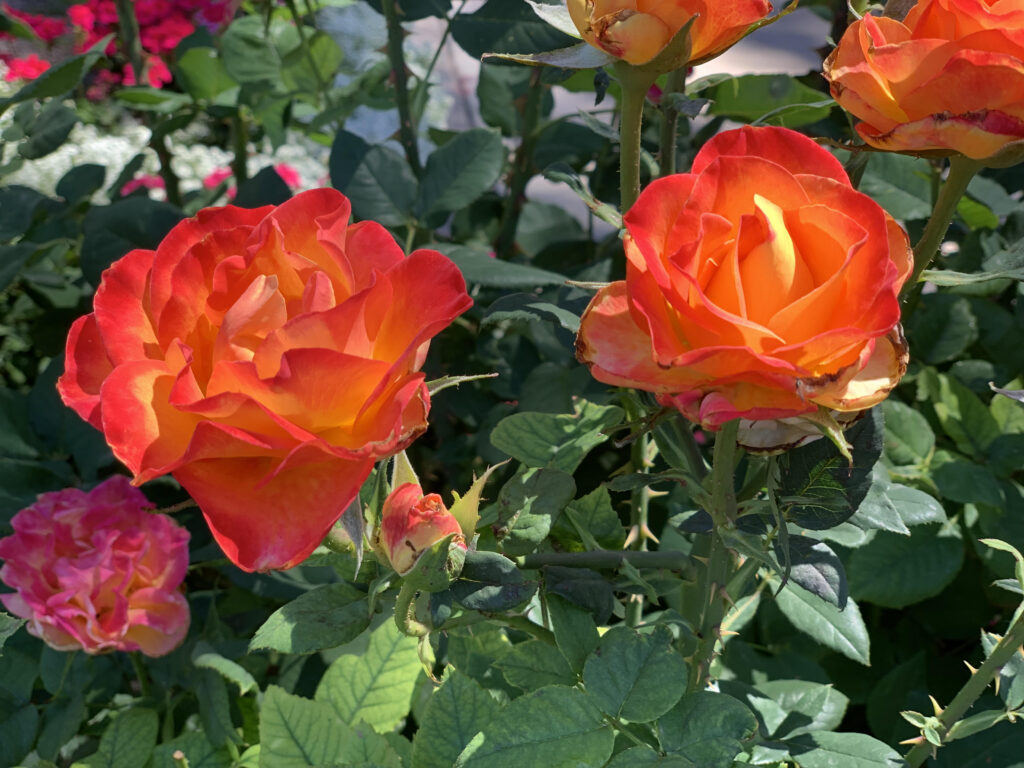Anywhere roses are expertly cared for, you will notice winter rosebushes have been pruned back to a few carefully chosen canes. While the prospect of pruning green branches and flower buds when they are actively growing and flowering may be daunting, this important ritual ensures large, profuse blossoms and healthy, pest resistant plants year after year. So clean and sharpen your best pruners- here are some important tips on the why, when and how to give your rosebushes a proper cutting back.
Why should I cut back my roses?
All living things need a rest and roses are no different. Cutbacks force roses into a short dormancy period, which helps each bush ‘spring’ forward with vigor during the blooming season as a healthier, more productive plant. Cutbacks also remove foliage where overwintering pests linger on the stems and leaves.
When should I cut back my roses?
In the Desert regions, each January- February, all established rosebushes should be cut and all foliage removed. If the plant has been in the ground less than two years, prune very lightly (dead or crossing branches) and never more than ⅓ of the plant volume. Blooms will reappear in about six weeks.
Important Techniques
- Sharpen all pruning equipment and sanitize blades between bushes to prevent the spread of disease (use a 10% bleach solution or other disinfectant)
- Cut ¼ inch above the nearest outward-facing bud with the cut at a 45 degree angle (ensures growth of the new bud towards the outside, keeping the center of the rosebush open for air circulation)
- If disease has been an issue in past years, consider treating larger cuts with an anti-fungal product (this is generally not an issue in our arid climate but can be a problem if there is overcrowding and poor circulation in your garden)
- If stem borers have been present in previous years, consider sealing cuts with wood glue
How do I get started?
Determine how low you should prune, which is dependent on the variety.

Floribunda & Iceberg Roses
These are shrub-like roses with ‘sprays’ of multiple, smaller blooms over top of the bush. It is also common to see these as climbing roses.
January: Prune canes to 24-32”, strip all leaves and flower buds.
September: Remove 30% of the past season’s growth, promoting fall blooming. Do not strip leaves in the fall.
Tea or Modern Long Stemmed Hybrid Rose
These bushes produce long stems with a single large rose on each stem, which are ideal for cutting and showcasing in a vase.
January: Prune canes to 18-24”, strip all leaves and flower buds.
September: Remove 30% of the past season’s growth to promote fall blooming. Do not strip leaves in the fall.
Tombstone or Lady Banks Rose
This bush has small white or yellow flowers on long, thin, vine-like branches that should be supported by a trellis or over an arbor. This is a large plant so make sure you have lots of space to allow it to grow in its natural form.
May/ June: Prune after blooming*, only removing dead, crossing branches that impede traffic or that have outgrown the space. Again, this plant is best if allowed to grow in a natural, wild shape.
*Flowers form on previous season’s growth, pruning before blooming may decrease flower production.
Pruning Sequence
- Remove dead, damaged or sucker canes (formed below the graft union)
- Remove canes that are crossing or growing in an inward direction- all canes should grow up and outward
- Remove branches that are smaller than the diameter of a pencil
- Carefully remove all leaves from remaining canes
- Water deeply after cutbacks
- Within a week of pruning, apply a complete fertilizer with 50% slow release nitrogen, plus magnesium and other necessary micronutrients
- Optional: apply worm castings or chicken manure for added organic matter and slow release fertilizer (worm castings also act as an insect repellent, helping to reduce aphid and whitefly populations)
- Topdress rose beds with organic mulch and water in well
While it can be difficult to remove all of the growth and blooms off of your roses when they may be in full bloom in the winter, it is important to force this dormancy period to allow roses to save energy for their ‘Main Event’, which generally occurs late spring in the Desert Southwest. Without this short dormancy, it is common for rosebushes to fizzle out before this time, reducing not only the number of blooms, but also the size of the flowers for the rest of the season. It also allows pests to linger on the leaves, giving them a head start on feeding on your prized roses in the spring. With mild winters, pest pressure in our gardens can be much higher, making it challenging to have healthy bushes. Stopping pests early in the season is a great way to reduce the likeliness of needing to resort to using pesticides in your garden to keep insects like aphids and thrips at bay. Now, get out those gloves, sharpen your gear and get to pruning!